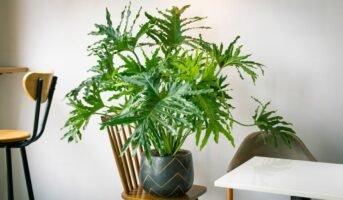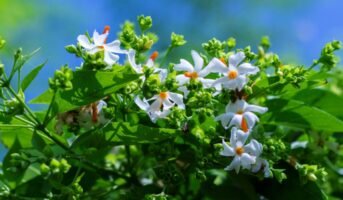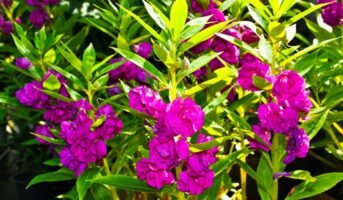The pet-friendly, nearly indestructible Pachira Aquatica or money tree plant can reach genuine statement size (around three metres.) This tropical tree is frequently found in workplaces, retail locations, and other public areas due to its inherent hardiness.
To reap the benefits of your money tree’s stunning canopy of gleaming green leaves and distinctive braided trunk, make sure it receives the appropriate quantity of water, light, and humidity.
Money tree: Key facts
| Botanical name | Pachira Aquatica |
| Common name | Money tree, Guiana chestnut |
| Height and growth rate | Fast growing- upto 3 metres |
| Light | Bright, indirect light |
| Watering | Up to the pot brim, avoid overwatering |
| Temperature | Household temperatures |
| Toxicity to pets | Non- toxic |

Source: Pinterest
Pachira Aquatica: Is money tree an indoor plant?
Pachira aquatica, sometimes known as the money tree, is a popular indoor plant with elegant umbrella-shaped leaves and a laid-back disposition.
Since it is not thought to be cold hardy, you should only grow this plant inside in colder climates. The money tree adds a touch of tropical flair and is the ideal complement to the inside environment.
If maintained adequately, Pachira Aquatica can last almost 10 to 15 years.
Where to grow a money tree?
Money trees thrive in moderate-to-high humidity and bright, indirect sunlight. Direct sunlight can cause the leaves to scorch. These plants can do just fine in relatively low light. However, exposure to drafts can cause it to lose its leaves. So, try to put it in a slightly shaded spot away from heater vents or a place that receives dry, hot air.
How to plant a money tree?
Start with a well-draining, nutrient-rich potting mix formulated specifically for houseplants. Make sure your chosen formula contains peat moss, which is enjoyed by money trees due to its loamy nature. Repot the money tree in a bigger container every two years to give it fresh soil and boost its growth and health.
How to grow a money tree?
Follow these steps to grow a money tree at home:
- Plant your money tree in a nutrient-rich and well-draining potting mix.
- Place it in a spot that receives bright, indirect sunlight away from vents.
- Water it deeply but make sure that you give the soil enough time to dry out between waterings.
- Regularly feed it with a slow-release fertiliser during summer and spring months.
- Prune it as required. You can also shape it like a bonsai.
- Braid your money tree from the button to give it its signature appearance.
How to propagate money trees?
Stem cuttings in the late spring or summer are the simplest method of propagating a money tree. Cut a stem between 10 and 15 cm long, and then submerge it in water for at least 2 cm. Plant in a small pot of peat-free cactus or house plant compost after a bundle of roots has formed.
Avoid the sun’s direct rays since they will burn the leaves. Set the temperature to between 12 and 24 °C. Bathrooms are the perfect environment for Pachira plants because they thrive there. It works well in fluorescent lighting as well, making it ideal for office settings.
Money tree: Care tips
Keep the following care tips in mind to maintain a money tree at home:
Water a money tree correctly
Keep in mind that Pachira Aquatica can store water at the base of its stems, so be careful not to overwater your money tree. Only water once the top 5 cm of the soil is completely dry. Make sure to drain away any extra water after. When the plant is not actively growing in the winter, water it less.
Maintain the right environment
The money tree thrives in an environment that is humid. Regularly mist the leaves or place them on a pebble tray filled with water. From spring until autumn, feed once a month with a balanced fertiliser every few weeks. To periodically remove accumulated dust, wipe the leaves.
Prune carefully
Pachira aquatica spreads quickly, but you can stop it from getting too big by pinching or trimming the growing points as needed. It can be kept in a smaller pot to control its development.
Don’t forget to repot
When the roots completely fill the pot, repotted into a little bigger container. Replace the top 5 cm of compost each spring, or sooner if the plant is too large.

Source: Pinterest
Pachira Aquatica: Problems
- Yellowing or withering leaves: Money tree plants are prone to root rot because they need generous but occasional irrigation. Make sure your planter has great drainage, and never let water stay in the saucer underneath your plant pot to help prevent root rot. Allow the compost to dry up before watering your Pachira Aquatica again if you believe you overwatered it.
- Shedding leaves: If the money tree plant is moved around a lot, it can become unruly and will regularly react by shedding its leaves. Once you’ve located the ideal location for it, make an effort to keep it there and only slightly rotate it if the amount of sunshine is inconsistent.
- Unwanted pests: A money tree plant can draw unwanted pests like aphids and mealybugs, like with most indoor plants. Neem oil can be used frequently to repel the majority.
Money tree: Benefits
- Pachira Aquatica is the best air-purifying plant because it absorbs the toxic components in the air. It cleans the air and makes your home a secure environment for you and your family.
- Money tree, adorned with beautiful braids, is aesthetically pleasing and will make a spectacular addition to your home decor.
- The plant prefers moist soil. If you’re always confused about how much water to give your indoor plants, the money tree is for you. It requires little care and will not die if overwatered.
- They are popularly gifted on housewarming and frequently used to adorn office décor.
- Pachira Aquatica is also planted for its edible seeds. When raw, they taste like peanuts, and when cooked, akin to chestnuts.
- The soft, light wood of Pachira Aquatica can be utilised to make rafts and buoys.
- The bark of the money tree is used for crafting belts and other handicrafts.
FAQs
Why is Pachira Aquatica referred to as the money tree?
A poor man is said to have begged for money and then found the Pachira Aquatica, brought it home, and started selling the plant's seeds to generate money. This is how the moniker money tree came to be.
Where in my home should I put a money tree?
When placed in the southeast corner of your home, or the area linked with money, money tree, a favoured indoor plant in feng shui, is said to bring good financial prosperity.
Is Pachira Aquatica toxic to your pets?
Money tree is an indoor plant that is suitable for pets. You can bring it home, and rest assured that your pets are always safe. Pachira Aquatica is non-toxic to humans, dogs, cats, and horses, but it shouldn't be consumed.
Housing News Desk is the news desk of leading online real estate portal, Housing.com. Housing News Desk focuses on a variety of topics such as real estate laws, taxes, current news, property trends, home loans, rentals, décor, green homes, home improvement, etc. The main objective of the news desk, is to cover the real estate sector from the perspective of providing information that is useful to the end-user.
Facebook: https://www.facebook.com/housing.com/
Twitter: https://twitter.com/Housing
Email: [email protected]











